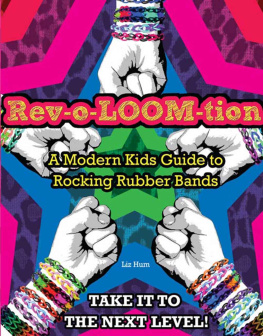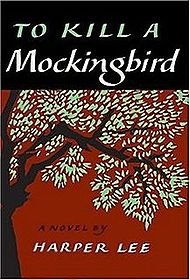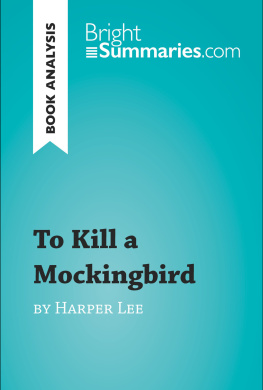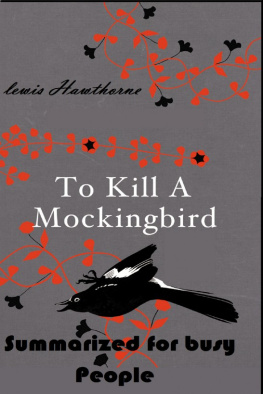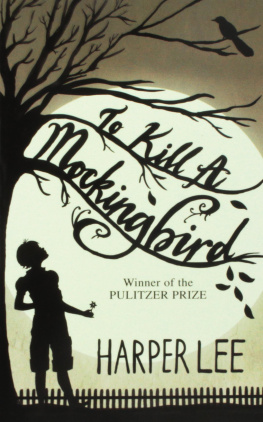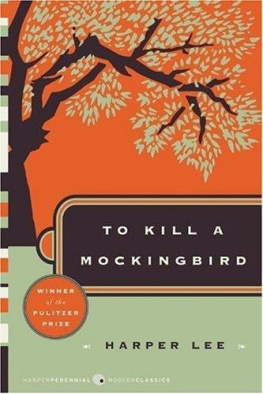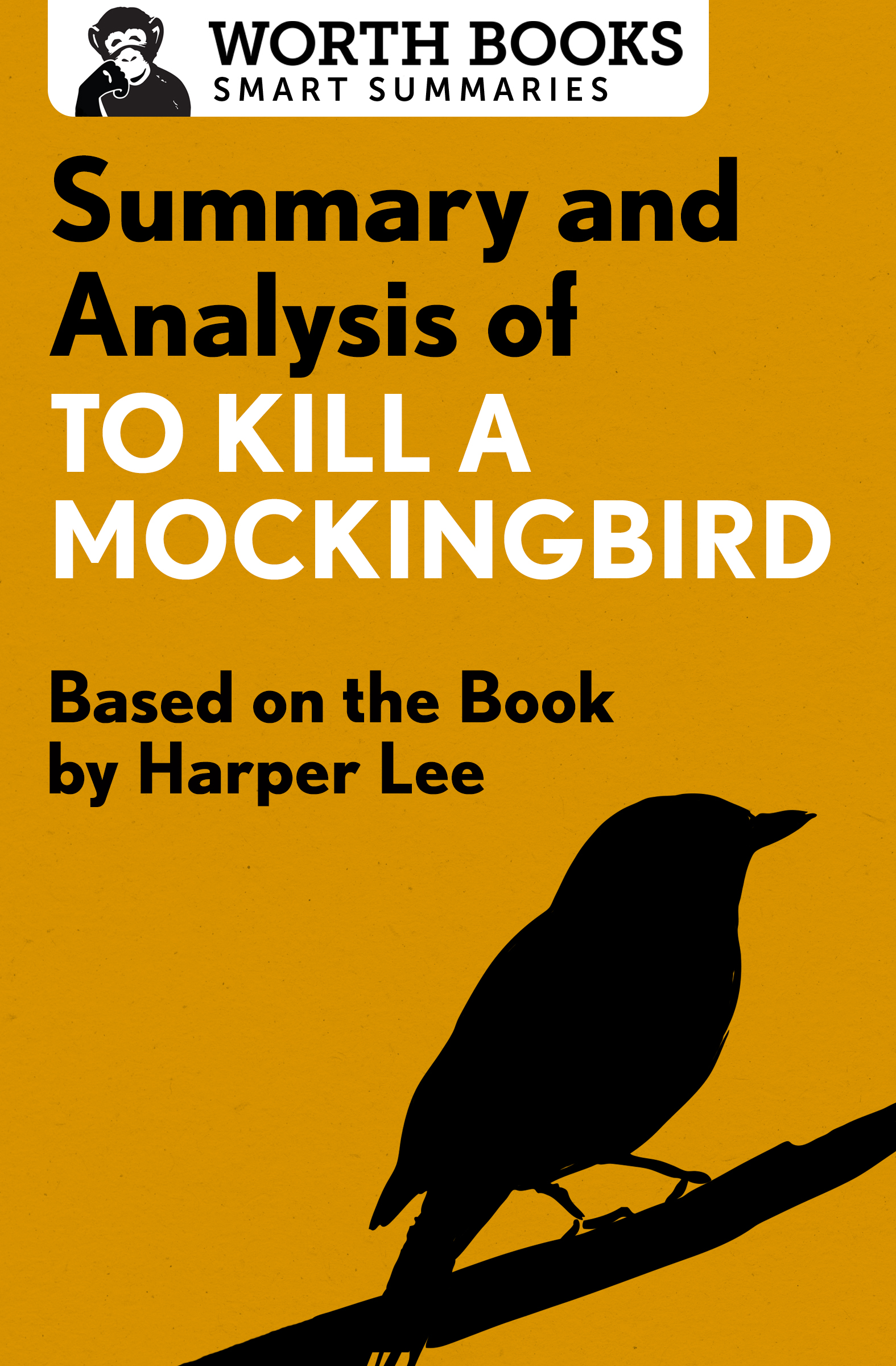Summary and Analysis of
To Kill a Mockingbird
Based on the Book by Harper Lee

Contents
Context
To Kill a Mockingbird is set in a small town in the Deep South during the Great Depression. It tells of the overwhelming prejudice and pervasive attitudes regarding class, race, and gender. The 1950s, when Harper Lee wrote To Kill a Mockingbird , was an era during which Jim Crow laws were still very much in place.
Since its publication in 1960, the novels honest depiction of prejudice continues to resonate throughout the world. The books release closely preceded the birth of the civil rights movement, thereby becoming a de facto textbook for examining Americas longstanding adherence to the culture of discrimination and racial injustice. At the same time, the story gives hope with its message of tolerance and compassion.
Though controversial for its timeespecially for its portrayal of the trial of a black man accused of raping a white woman To Kill a Mockingbird won the Pulitzer Prize for fiction the year it was published.
Film legend Gregory Peck was cast as protagonist Atticus Finch in a 1962 film adaptation, and the novel has grown to become one of the most beloved and important novels of the twentieth century.
The historical and sociological significance of the book is undeniable; it contains themes that harken back to Americas slave-owning past, and it shines a light on the struggles that still persist today.
Overview
To Kill a Mockingbird revolves around a widower and lawyer, Atticus Finch, and his two children, Jem and Scout, set in a sleepy Southern Alabama town.
Dill is the Finch childrens summertime playmate from Mississippi. He returns each year to visit his aunt and acts as a catalyst for the kids many adventures. Dills wild imagination is mostly fixated on the towns mysterious recluse, a man called Boo Radley.
Bright beyond her years, Scouts been reading since she was a toddler and finds school a waste of time. She has a tendency to be hotheaded and somewhat rebellious. Atticus offers his daughter a life lesson in tolerance and empathy that will serve as the cornerstone of her character.
Scout struggles to walk the line between her tomboyish proclivities and the expectations Southern culture placed on girls. She often turns to her neighbor and mentor, Miss Maudie, for advice in coping with her growing pains.
The children try unsuccessfully to draw Boothe recluse whom neighborhood kids have made the center of their curiositiesout of his safe haven of anonymity. One plan involves a note at the end of a fishing pole, which is thwarted by Atticus. He beseeches the children to leave poor Boo alone.
The childrens obsession with Boo comes to a critical juncture on the eve of Dills departure for the season. Going against Atticus Finchs direct order, a clandestine outing to the Radley house is met with the elder Radleys shotgun, having been mistaken for a Negro trying to steal vegetables from his collard patch. The three kids narrowly escape.
The Finch family find themselves at the epicenter of a crisis of conscience that rocks the foundation of Maycomb society. The children show uncommon restraint and dignity by standing up against a mob of angry men hell-bent on lynching Tom Robinson, an innocent black man accused of raping Mayella Ewell. The mens retreat is a direct result of the childrens unbridled innocence and courage.
The rape trial begins, shedding light on the deep-seated bigotry and hatred that exists among Maycombs citizens. At their young ages, Scout, Jem, and Dill must confront fundamental issues of right and wrong. Watching their fatherToms lawyerconduct himself with his family and neighbors and throughout the trial, they have an opportunity to see Atticus as a champion of truth and justice.
Winning a rape trial in which its the word of a Negro man against that of a white woman is a gargantuan task. Atticus harbors no illusions. Standing in the courtroom, he presents his case for the defense competently, but hes unable to overcome narrow-minded attitudes of 1930s Alabama. Arguing against a white girls word falls on deaf ears, and an innocent man is convicted of a crime he didnt commit. Atticuss efforts dont go unnoticed; the entire gallery of black citizens stand up in respect for the white lawyer who went against the establishment on their behalf.
A death threat by Bob Ewell, the father of the girl who accused Tom Robinson, leaves the Finches on edge. Jems maturity enables him to face the ugly facts about racism, bigotry, and class warfare in the South. The young man questions his faith in human nature and understands why Boo might want to distance himself from others.
During the month of October, subtle signs emerge that a reprisal aimed at the Finch family is on the horizon. On the way home from their schools Halloween pageant, Jem and Scout are viciously attacked by a stranger in the dark schoolyard. Scouts vision is impaired by her costume, so she can only hear the sounds of the assault. Flailing about, Scout runs directly into the clutches of an unidentified man who tries to suffocate her. In the nick of time, someone rescues them. Through her peepholes, Scout cant make out who it is.
The Sheriff finds Bob Ewell in the woodsdead, with a kitchen knife stuck in his gut. Jem is unconscious and has a broken arm. A man that Scout doesnt recognize is hiding behind the door. She soon learns that its Boo Radley, the man who rescued them and killed Mr. Ewell.
Like killing a mockingbird, Sheriff Tate sees no good in exposing Boo to the glare of the public eye. It would, in effect, punish Boo for saving two children and ridding the town of evil.
Scout ponders the events of the last three years and fully grasps the awesome truth in Atticuss lesson of tolerance: You never really know a man until you stand in his shoes and walk around in them.
Cast of Characters
Aunt Alexandra: Atticus Finchs strong-willed, traditional sister. She lives with the Finches during Tom Robinsons trial, and is very concerned about Scouts tomboyish ways.
Maudie Atkinson: Miss Maudie is a supportive elderly neighbor, friend, and mentor to the Finch children.
Calpurnia (Cal ) : The Finch familys loyal housekeeper and church-going mother figure.
Walter Cunningham Sr.: A poor white man and one of the members of the mob that wants to lynch Tom Robinson. However, hes also one of Atticuss clients and after speaking with Scout, he calls off the mob.
Walter Cunningham Jr.: A classmate of Scouts, Walter is from a poor family. Jem invites him to lunch at his house one day.
Link Deas: An honest man; Tom Robinsons employer, who praises the integrity of Toms character. Deas is not racist like his neighbors.
Mrs. Henry Lafayette Dubose: An elderly, racist, and unpleasant neighbor of the Finch family. Jem learns to respect her in her courageous attempt to battle her morphine addiction.
Bob Ewell: Hateful, racist drunk and Atticuss archenemy. He and his daughter, Mayella Ewell, accuse Tom Robinson of assaulting her.
Mayella Ewell: Bob Ewells unhappy nineteen-year-old daughter. She wrongly accuses Tom Robinson of raping her.
Atticus Finch: Small-town lawyer, widower, and Jem and Scouts benevolent father.
Jean Louise Scout Finch: The novels narrator. She is a bright and precocious tomboy; daughter of Atticus; Jems younger sister.
Jeremy Atticus Jem Finch: Atticuss eldest son and protective older brother of Scout.







